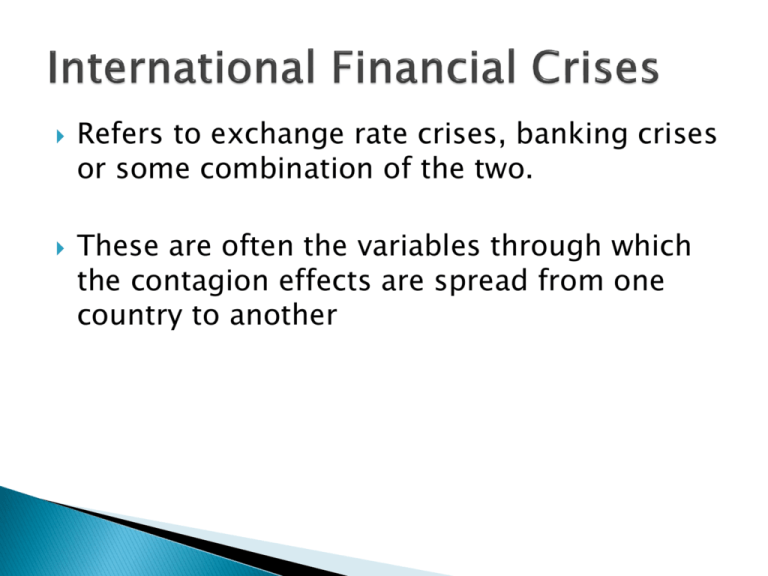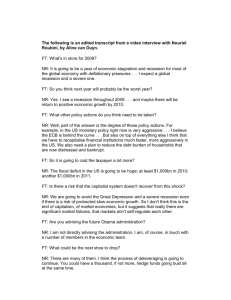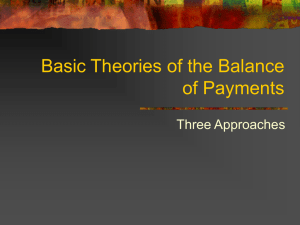Chapter 17
advertisement

Refers to exchange rate crises, banking crises or some combination of the two. These are often the variables through which the contagion effects are spread from one country to another Economic integration = opportunities for growth and development but also = Easier for crises to spread from one country to another e.g. 1992 currency speculation against British pound and other European currencies = near collapse of monetary arrangements in Europe A banking crisis occurs when The banking system becomes unable to perform its normal lending functions and some or all of a nation’s banks are threatened with insolvency. (net worth is negative = assets are less than liabilities) If banks cannot pay its creditors (depositors) because its debtors (businesses, loans) have gone under or defaulted = Disintermediation When depositors lose their money (unless they have deposit insurance), Consumption drops, new investments slows down, economy falls into deep vicious circle of recession. Sudden and unexpected collapse in the value of a nation’s currency. May occur in either fixed or flexible regimes but research shows that countries with fixed regime are more vulnerable to this type of crisis Result is steep recession e.g. A country borrows large amounts in international capital markets. Country’s currency collapses value of debt increases Many banks fail capital outflow and no new I economy goes into deep recession 5 Banking system is the channel for transmitting recessionary effects Prior to the Asian crisis, banks borrowed dollars in capital markets. When home country currency collapsed, dollar value of debt increased. Many banks failed. Disintermediation took place and economies slid into deep recession 1994, speculation against the Mexican peso = its collapse and spread of “Tequila effect” through out South America. 1997 several East Asian economies were thrown into recession by a wave of sudden capital outflows Contagion effect = not a single pattern = different rules of behavior 7 2 Sources 1. Macroeconomic imbalances 2. Volatile flows of financial capital that quickly move in and out a country (sudden changes in investor expectations may be the triggering factor) 8 Macroeconomic Imbalances -Best example is Third World Debt crisis (1980) -Overly expansionary fiscal policies creating large government deficits financed by high growth of money supply -potential problems of government spending are compounded by inefficient and unreliable tax systems Tax revenue may be insufficient for government expenditure 9 -Governments resort to selling bonds to finance expenditures but capital markets are underdeveloped -So governments require central banks to buy the bonds -Money supply increase -Inflationary pressure -currency becomes overvalued -everyone tries to sell domestic assets and convert them to foreign exchange -Government begins to run out of international reserves -pressure on currency to depreciate 10 If exchange rates are fixed serious repercussions on real value of the exchange rate Capital flight if people begin to think exchange rate is overvalued and correction is likely in future In addition to large budget deficits and inflationary pressures is a large and growing current account deficit. People try to sell their domestic assets and acquire foreign ones run on a country’s international reserves Portfolio managers look at actions of each other for information about the direction of the market Herd mentality A small trickle of funds can be fueled by speculations which can lead to a huge capital flight. 12 When this happens, international reserves disappear, exchange rates tumble and weakens the financial sector A weak financial sector intensifies the problems 13 Steps Countries can take to minimize likelihood of crises and damage they cause when they happen -maintain credible and sustainable fiscal and monetary policies -engage in active supervision and regulation of the financial system -provide timely information about key economic variables such as central bank holding of international reserves 14 Elements of macro imbalances, volatile capital flows and financial sector weakness. Overvalued real exchange rates, current account deficits because domestic savings could not support investments In 1990 – 1993 capital inflows of $91B made up of private investment, direct investment and bank loans 15 In 1994, interest rate movements led to large losses for banks and investors Investors called for reducing level of exposure to Mexico Dec. 1994, newly elected president, Zedillo, announced a 15% devaluation 16 Currency speculators had expected a 20 – 30% devaluation Zedillo’s announcement sent financial markets into turmoil More capital fled the country Dollar reserves shrank. Though 2 days after the announcement, Mexico said it would move to a flexible exchange rate, the damage had already been done 17 Both domestic and foreign capital continue to leave the country By March 1995, peso had lost more than 50% of its value NAFTA and IMF helped in the form of line of credit and loans with conditions of decreasing G and increasing T 18 Began in Thailand in July 1997 and spread to Malaysia, Philippines, Indonesia and South Korea Symptoms of crisis were fairly similar across countries -currency speculation and steep depreciation -capital flight -financial and industrial sector bankruptcies 19 Countries had large trade deficits (on average 5.2% of GDP, Thailand had a deficit of 8% of GDP) the year before the crisis Large current account deficits = large capital inflows Because for last 30 years these countries averaged 5% growth in GDP and foreign investors had no reasons to believe otherwise Also, Japan and Europe were losing grounds in growth and investors were looking elsewhere 20 Exchange rates in the region were pegged to the dollar dollar appreciating in the 90s meant many exchange rates appreciating as well. Exchange rates were harder to sustain because it became more difficult to export. CA deficits increased Financial sector problems because of family ties 21 Investors lost confidence in Thailand to keep its exchange rate pegged People began to suspect devaluation and refused to hold Thai baht 22 Many loans to the Thai financial sector were in dollars so this raised the cost of devaluation Thailand served as a wake-up call to investors in the region Others think the devaluation in Thailand made exports from other countries less competitive which led them to devalue as well. Whatever the case, the Thailand experience had a contagion effect 23 Effect spread to countries as far as Brazil and Russia With the exception of Singapore and Taiwan, every country affected by the crisis experienced a recession in 1998 Singapore and Taiwan had had large surpluses so they concentrated on domestic economies rather than defending their currencies IMF helped with loans and conditions of interest rate hikes. Capital controls were implemented in some countries 24 In the 1980s, high interest rates and an appreciation of the US dollar caused the burden of dollar denominated debts in Argentina, Mexico, Brazil and Chile to increase drastically. A worldwide recession and a fall in many commodity prices also hurt export sectors in these countries. In August 1982, Mexico announced that it could not repay its debts, mostly to private banks. After liberalization in 1991, Russia’s economic laws were weakly enforced or nonexistent. ◦ There was weak enforcement of banking regulations, tax laws, property rights, loan contracts, and bankruptcy laws. ◦ Financial markets were not well established. ◦ Corruption and crime became growing problems. ◦ Because of a lack of tax revenue, the government financed spending by seignoirage. ◦ Interest rates rose on government debt to reflect high inflation from seignoirage and the risk of default. The IMF offered loans of official international reserves to try to support the fixed exchange rate conditional on reforms. But in 1998, Russia devalued the ruble and defaulted on its debt and froze financial asset flows. Without international financial assets for investment, output fell in 1998 but recovered thereafter, partially due to the expanding petroleum industry. Inflation rose in 1998 and 1999 but fell thereafter.









